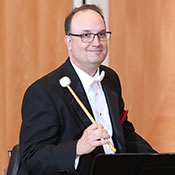
Not More Cowbell, Better Cowbell
Paul Kosidowski
PUBLISHED
Tagged Under: 2019.20 Season, Meet the Music in Minutes, MSO Musicians, Percussion
MSO Percussionists are very particular about the quality of their sound. First rehearsal. MSO musicians file on to the Uihlein Hall stage, unpacking violins and bows, adjusting reeds on clarinets and bassoons, arranging music on stands. In the percussion section, there’s a tambourine, cymbals, triangle, castanets—exactly what you’d expect for a program of Spanish flavored music.
But wait. There are actually a several triangles, a bunch of tambourines, even three different snare drums. Exactly how many percussionists does Chabrier’s Espana require or Bizet’s Carmen Suite require?
The collection will be considerable smaller by the time October 4 rolls around, when the orchestra opens its weekend of Sounds of Spain concerts, with Jun Märkl conducting. You might think one tambourine sounds like another, but these instruments have to pass an audition of sorts before they are used in a performance.
“During rehearsals, we try different combinations of instruments,” explains Christopher Riggs, the MSO’s acting principal percussionist. “We figure out the right balance and color palette we’re going to use for a given piece. We keep whittling down until we know exactly what we’re using for the concert.”
That applies to every thing that is struck, pinged, or shaken. Even to the massive bass drum, which is a particular concern to Dean Borghesani, the MSO’s principal timpanist.
“I want the world to know how picky I am about the bass drum,” Borghesani says with an evangelist’s fervor. “That instrument is the fifth timpani. It’s such an expressive instrument, but soooo many people take it for granted. They just…hit it.”
To get the most out of the sound, both sides of the drum have to be carefully tuned, and the playing requires a sensitive and subtle touch. “I always want the most mature player in the section on that instrument,” he says. Chris and Rob Klieger are so good at bringing that instrument to life.”
Picking that player—and others—is part of the job for Borghesani and Riggs as staff percussionists in the orchestra (Robert Klieger is currently on a year-long leave). And for a program like “Sounds of Spain,” filled with music inspired by Spanish dance rhythms, the choices really matter.
The musicians have to know their instruments, of course. But they must also have a feel for the rhythms that goes beyond what’s written on the page. Borghesani calls it “stylizing the rhythm.”
“It’s kind of implied and expected,” he explains. “The composer can’t really write the rhythm mathematically to exactly reflect that style. So it’s important to understand the history of the piece—where it comes from, or that it’s based on a certain dance.” As a player, you need to understand that from the beginning, but the conductor might have his or her own ideas.
Riggs explains. In Carmen, the familiar Aragonaise is based on a dance from Spain’s Aragon region. It’s a charged (think bullfight) string of accented notes—dun-digah-dun-dun-dun-dun. One way to play it, Riggs says, “is to play it mathematically, as written. But to evoke the style of it, you need to crunch the 16th notes a little.” (The digah-dun in the middle.)
It’s up to the conductor, of course. But, Riggs says, “You have the freedom to stylize the rhythms. The music almost requires it to evoke the style of the pieces.”
Those stylized rhythms are what attracted non-Spanish composers like Rimsky-Korsakov and Emmanuel Chabrier to these rhythms in the first place. And getting the sound and the rhythms just right is the key to these radiant masterpieces of orchestral color.


